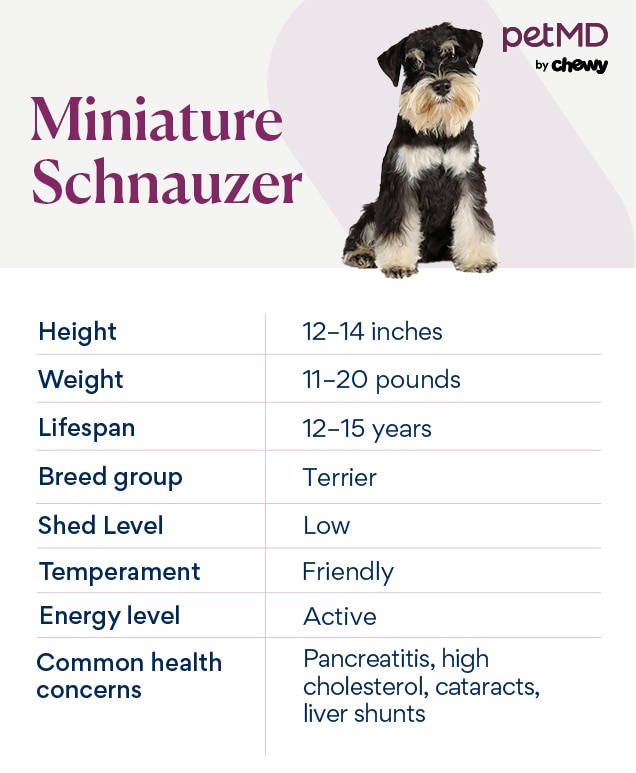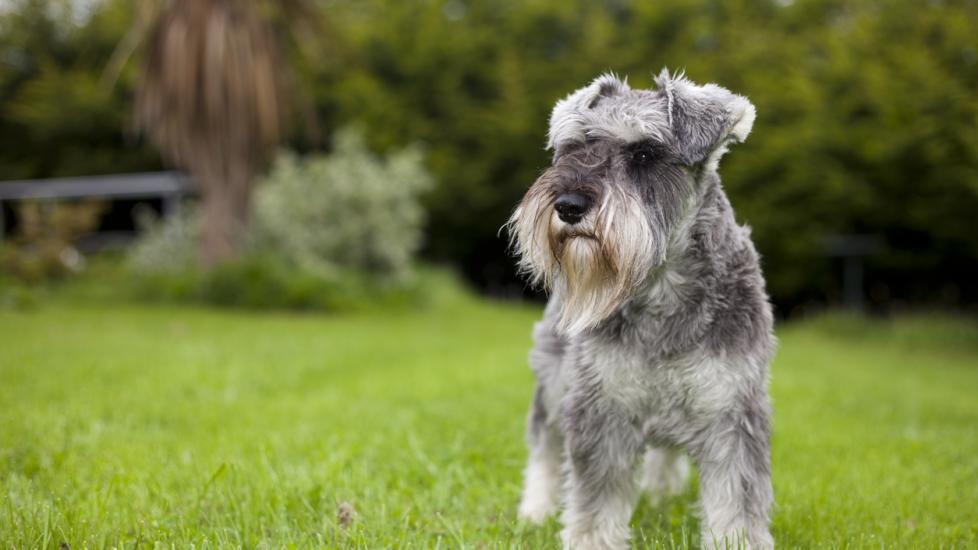Miniature Schnauzer
The Miniature Schnauzer is descended from an old, hardworking breed of German dogs historically used to pull carts, herd livestock, and hunt rats. Today, the friendly, whip-smart breed makes an excellent and adaptable family pet.
The first image of a Schnauzer dog dates back to the late 1400s, according to the American Miniature Schnauzer Club (AMSC). Their long beards gave the breed their name: Schnauze is the German word for muzzle.
Miniature Schnauzers are small dogs that are generally between 12–14 inches tall at the shoulder and weigh between 10–20 pounds. They are the smallest of the three Schnauzer sizes, the other two being the Giant and Standard Schnauzer.
Caring for a Miniature Schnauzer

Mini Schnauzers are bright and charismatic dogs that can adapt to life in a city apartment as well as on a sprawling farm. They enjoy play as well as a good snooze, but Miniature Schnauzers still need at least an hour of exercise a day, as well as mental stimulation to keep their active minds occupied. They enjoy walks, puzzle games, agility, and learning new tricks.
They’re sturdy dogs that, despite their prolific facial hair, don’t shed much. In fact, Miniature Schnauzers can make good pets for some people with dog allergies, though no dog is 100% hypoallergenic.
Miniature Schnauzer Health Issues
Miniature Schnauzers are generally healthy dogs with a life expectancy of between 12–15 years. When purchasing Miniature Schnauzer puppies, the AMSC recommends asking about the health of the puppy’s parents, as this breed can be prone to certain health conditions.
Cataracts
Cataracts are a condition that creates cloudiness on the lens of the eye, causing reduced vision and sometimes blindness. This is a hereditary condition in Miniature Schnauzers, but cataracts can also be caused by diabetes or trauma. Surgery can remove cataracts and restore vision.
High Cholesterol (Hyperlipidemia)
A condition called hyperlipidemia can also affect Miniature Schnauzers, according to the breed club. This results in increased levels of fat in the blood and can be caused by endocrine disorders, genetics, obesity, medications, and other health problems, according to the British Small Animal Veterinary Association (BSAVA).
Veterinarians use blood tests to diagnose the condition, and treatment—which can include medicine, supplements, or a low-fat and high-fiber diet—depends on the underlying cause.
Pancreatitis
Miniature Schnauzers are predisposed to pancreatitis. This is when the pancreas has an inflammatory reaction and causes lethargy, abdominal pain, vomiting, dehydration, and loss of appetite. Sometimes pancreatitis can cause collapse and shock, which can be fatal.
Treatment depends on severity and primarily consists of supportive care and treating the symptoms. This can be anything from taking antinausea and pain medication at home to days (or even weeks) of IV fluid support while hospitalized.
Liver Shunts
Liver shunts describe an abnormal blood flow that bypasses the liver. This is problematic because the liver filters and detoxifies blood, so dogs with liver shunts can experience symptoms such as:
-
Bloody diarrhea
-
Bloody vomit
-
Weight loss
-
Poor appetite
-
Increased thirst and urination
-
Mental dullness
Treatment and prognosis depend on whether the shunt is located within or outside the liver.
Mycobacterium Avium Complex
Rarely, Miniature Schnauzers can inherit Mycobacterium Avium Complex (MAC), a deadly immune disease. The condition was believed to be passed down through a specific family of Miniature Schnauzers, according to the breed club. The disease can be detected through genetic testing, and symptoms include lethargy, lack of appetite, weight loss, weakness, and diarrhea.
What To Feed a Miniature Schnauzer
Mini Schnauzers, though small, need a well-balanced diet to keep them fueled up for their active lifestyles. They should be fed dog food that’s approved by the Association of American Feed Control Officials and formulated for small dogs.
How To Feed a Miniature Schnauzer
Adults should be fed twice a day, though Miniature Schnauzer puppies can be fed small, more frequent meals (three or four per day) on a regular schedule.
How Much Should You Feed a Miniature Schnauzer?
The AMSC recommends feeding a quality kibble with a fat content between 10%–15%. Schnauzers, like all dogs, require a health balance of fiber, vitamins, fats, and proteins. Calorie needs depend on your dog’s age, size, and activity level.
But don’t let those cute little bearded faces persuade you to feed them more than they need: Overweight Schnauzers are more prone to serious health conditions. “Schnauzers love to eat,” the AMSC states, “and can easily con their owner into overfeeding them at mealtime or with multiple treats all day. Measure amounts, and do not self-feed or free feed.”
Nutritional Tips for Miniature Schnauzers
Your dog should get all the nutrients he needs in his AAFCO-approved dog food. Your veterinarian can give guidance on whether additional supplements are needed.
Behavior and Training Tips for Miniature Schnauzers
Miniature Schnauzer Personality and Temperament
Mini Schnauzers are smart and spunky dogs who love people. They’re energetic but eager to please their family by following cues and commands. Well-trained Miniature Schnauzers do well with kids and other family pets, making fun playmates.
Miniature Schnauzers can make good pets for some people with dog allergies, though no dog is 100% hypoallergenic.
Because Schnauzers of all sizes come from a working-dog heritage, many enjoy having a job to do. Try enrolling your Miniature Schnauzer in dog sport classes, such as agility or obedience competitions, so he can give his body (and brain!) a workout.
Miniature Schnauzer Behavior
Mini Schnauzers are alert dogs, which means they can be especially vocal and bark at neighbors, delivery people, and neighborhood squirrels.
Speaking of barking at neighborhood animals, spunky Miniature Schnauzers can sometimes think they’re much bigger than they actually are. Their history as rat-catching dogs means some are more prone to chasing anything that moves, which can easily get them into trouble. Mini Schnauzers should always be kept on a leash or within a fenced-in yard when they’re outside to prevent them from darting off.
Miniature Schnauzer Training
Schnauzers love to please their people and are amenable to many types of training. Once your Miniature Schnauzer puppy masters the basics of “sit” and “stay,” try teaching him more involved tricks or how to run an agility course. As long as you use positive reinforcement and keep sessions fun, your Schnauzer dog will love the challenge.
Fun Activities for Miniature Schnauzer
-
Agility
-
Obedience competitions
-
Barn hunt
Miniature Schnauzer Grooming Guide
To maintain a Miniature Schnauzer’s well-coiffed look, the breed’s wiry, medium-length coat requires a lot of grooming, both by their pet parents and a professional.
Skin Care
Miniature Schnauzers don’t require any specific skin care, though owners should keep an eye out for dry skin, abrasions, or other abnormalities. Talk to your veterinarian if you notice anything concerning about your Schnauzer’s skin.
Coat Care
Schnauzers have a double coat—a wiry top layer on top of a softer undercoat. They require regular trims to keep their hair healthy and their mustache tidy. Miniature Schnauzers should see a professional groomer at least once every eight weeks.
Brushing your Schnauzer at least once a week also helps reduce tangles and mats. The Schnauzer’s signature beard may need more upkeep than the rest of his body, as it may become discolored from eating or playing.
Eye Care
Pet parents need to pay special attention to the hair around their Miniature Schnauzer’s eyes, as it can block the dog’s vision. Keeping their hair trimmed will help.
Ear Care
Miniature Schnauzers aren’t prone to ear infections. However, pet parents need to clean their pup’s ears with a dog-specific ear cleaner every time their dog is in water, such as after a bath or a swim. Otherwise, moisture can become trapped in their canals and cause an infection.
Considerations for Pet Parents
Mini Schnauzers crave the attention and presence of their family, according to the AMSC, and shouldn’t be left alone to entertain themselves all day. Prospective Schnauzer pet parents need to have enough time to spend with their new friend.
“They need to live as a part of their family, going where they go, doing what they do,” according to the AMSC.
As long as you have time to devote to them, Schnauzers are affable and adaptable, making them good pets for many types of families. As long as they are given enough exercise and attention, they make a wonderful and charming addition to any household.
Mini Schnauzers crave the attention and presence of their family and shouldn’t be left alone to entertain themselves all day.
Miniature Schnauzer FAQs
What are the different Schnauzer sizes?
At 12–14 inches tall, Miniature Schnauzers are the smallest of the three Schnauzer dogs. Standard Schnauzers are larger, at 17–20 inches tall, while Giant Schnauzers are the biggest and stand 24–28 inches tall.
How long do Miniature Schnauzers live?
The typical Miniature Schnauzer lifespan is 12–15 years.
Do Miniature Schnauzers bark a lot?
Miniature Schnauzers are alert and intelligent dogs that can serve as good watch dogs. They can be known to be vocal, though good training can help minimize unwanted barking.
Are Miniature Schnauzers good pets?
Miniature Schnauzers make good pets for many types of households. They are happiest when they are with their people—no matter where that may be.
Featured Image: iStock/Feverstockphoto
